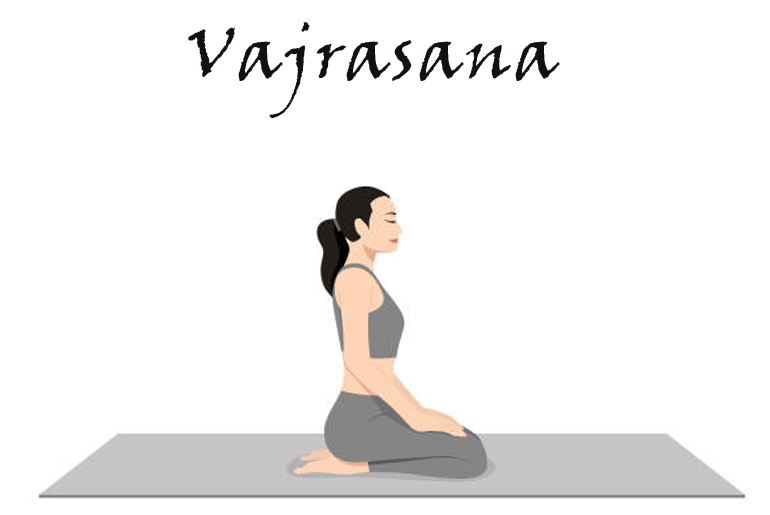Vajrasana, derived from the Sanskrit word ‘Vajra’ meaning Thunderbolt or Diamond, is a well-known yoga posture with significant physical and mental health benefits. This simple yet powerful seated pose involves kneeling with the buttocks resting on the heels and hands placed on the thighs. Practicing Vajrasana improves digestion, enhances blood circulation, strengthens the back and legs, and promotes relaxation by calming the mind. It is also known to aid in weight management, relieve lower back pain, and support meditation by improving focus. Regular practice of Vajrasana can contribute to overall well-being, making it a valuable addition to a daily yoga routine.
Vajrasana is a kneeling yoga posture where you sit on your heels with a straight spine and relaxed shoulders. Unlike many other yoga poses, it can be practiced anytime, even after meals, as it aids digestion. This pose also supports meditation and pranayama by promoting focus and relaxation, making it a versatile and beneficial addition to a daily routine.
How to Do Vajrasana
Start on Your Knees:
- Kneel on a yoga mat with your knees together.
- Keep your feet flat on the floor, with toes pointing straight back.
Sit on Your Heels:
- Gently lower your hips to rest on your heels.
- If you feel discomfort in your knees or ankles, place a cushion or folded blanket under your hips.
Position Your Hands:
- Rest your hands on your knees with palms facing down or up.
- Keep your fingers relaxed.
Straighten Your Spine
- Engage your core and maintain an upright posture.
- Keep your neck and head aligned with your spine. Avoid leaning forward or backward.
Relax and Breathe
- Close your eyes if comfortable.
- Take slow, deep breaths in and out.
- Hold the pose for a few minutes or as long as comfortable.
Would you like modifications or benefits of Vajrasana included as well?
Steps to Perform Supta Vajrasana:
Begin in Vajrasana
- Sit in Vajrasana with your knees together and feet flat on the floor.
- Keep your back straight and hands resting on your thighs.
Lower Your Back Slowly
- Place your hands behind you for support.
- Lean back gradually, first resting on your elbows, then slowly lowering your upper back to the floor.
Fully Recline on the Ground
- Once comfortable, rest your back completely on the mat.
- Let your arms relax alongside your body or extend them overhead for a deeper stretch.
- Your knees should remain bent and close together.
Hold and Breathe
- Close your eyes and take deep, slow breaths.
- Hold the position for 30 seconds to a few minutes, depending on your comfort level.
Come Back Up Slowly
- To release, bring your elbows back to the mat for support.
- Engage your core and slowly lift your upper body, returning to Vajrasana.
Vajrasana Posture: Tips to Correctly do it
To ensure you maintain the correct vajrasana posture, keep the following in mind:
- The knees and thighs should be in a straight line.
- The shoulders should be relaxed with the spine straight.
- Your chest should be open, and your abdomen should feel relaxed.
Benefits of Vajrasana:
Vajrasana is a simple yet powerful yoga pose that offers a wide range of benefits for both the body and mind. It is one of the few yoga postures that can be practiced immediately after meals, making it unique and highly effective for overall well-being.
1. Improves Digestion: One of the biggest advantages of Vajrasana is its ability to enhance digestion. Sitting in this pose directs blood flow to the digestive organs, improving their function and reducing issues like indigestion, acidity, and constipation. It also helps in better absorption of nutrients, making it beneficial for people with weak digestion. Regular practice of Vajrasana can prevent bloating and discomfort after meals.
2. Enhances Posture and Strengthens the Spine: Vajrasana encourages proper spinal alignment by promoting an upright sitting posture. By keeping the back straight and shoulders relaxed, it prevents slouching and helps in correcting poor posture. This pose is especially useful for individuals who spend long hours sitting at a desk, as it strengthens the lower back and prevents spinal discomfort. Over time, Vajrasana contributes to a more stable and healthy posture.
3. Increases Lower Body Flexibility: This pose stretches the thighs, knees, ankles, and feet, improving flexibility in these areas. Regular practice of Vajrasana strengthens the knee and ankle joints, making it beneficial for those who experience stiffness or discomfort in their lower body. It is also helpful for athletes or individuals recovering from leg injuries, as it improves joint mobility and reduces muscle tension.
4. Reduces Stress and Promotes Mental Calmness: Vajrasana is not just beneficial for the body but also for the mind. By focusing on deep and steady breathing while sitting in this pose, you can calm the nervous system, reducing stress and anxiety. This makes it an excellent posture for meditation and mindfulness practices. It helps in improving concentration, mental clarity, and emotional stability, making it a great tool for stress management.
5. Improves Blood Circulation and Regulates Blood Pressure: Practicing Vajrasana regularly promotes healthy blood circulation, especially in the lower body and abdominal region. This improved circulation ensures that vital organs receive adequate oxygen and nutrients, supporting overall health. Additionally, by stabilizing blood pressure levels, Vajrasana may help in preventing hypertension and promoting cardiovascular well-being.
6. Aids in Managing Diabetes: Studies suggest that Vajrasana can help regulate blood sugar levels by stimulating the pancreas and improving insulin sensitivity. It enhances metabolism and assists in better glucose absorption by the body. When combined with a balanced diet and an active lifestyle, this pose can be a helpful addition to a diabetes management routine.
7. Relieves Lower Back Pain: For individuals suffering from lower back pain, Vajrasana can provide significant relief. By strengthening the muscles supporting the lumbar spine, this pose reduces tension and strain in the lower back. It also helps in alleviating discomfort caused by prolonged standing or sitting, making daily movements more comfortable.
8. Supports Meditation and Breathing Exercises: Since Vajrasana provides a stable and comfortable sitting posture, it is widely used for meditation and breathing exercises (pranayama). The calm and composed position helps individuals focus better, enhancing their ability to practice deep breathing techniques. This leads to increased oxygen supply to the brain, further improving overall mental and physical health.
Position Vajrasana: Making It Comfortable
To make Vajrasana more comfortable, ensure proper posture by keeping your spine straight and shoulders relaxed. If you experience discomfort in your knees or ankles, place a folded blanket or cushion under your shins or between your thighs and calves for support. Gradually increase the duration of holding the pose to allow your body to adapt. Engaging in gentle ankle and knee stretches before practicing Vajrasana can also enhance flexibility and reduce stiffness.
In conclusion, Vajrasana is a simple yet powerful yoga pose that can be practiced anytime, anywhere. By following the correct posture and practicing consistently, you can experience its numerous benefits, including improved digestion, reduced stress, and better posture. Regular practice enhances its positive effects, making it a valuable addition to your daily routine for overall well-being.
Disclaimer:
The information contained in this article is for educational and informational purposes only and is not intended as a health advice. We would ask you to consult a qualified professional or medical expert to gain additional knowledge before you choose to consume any product or perform any exercise.






